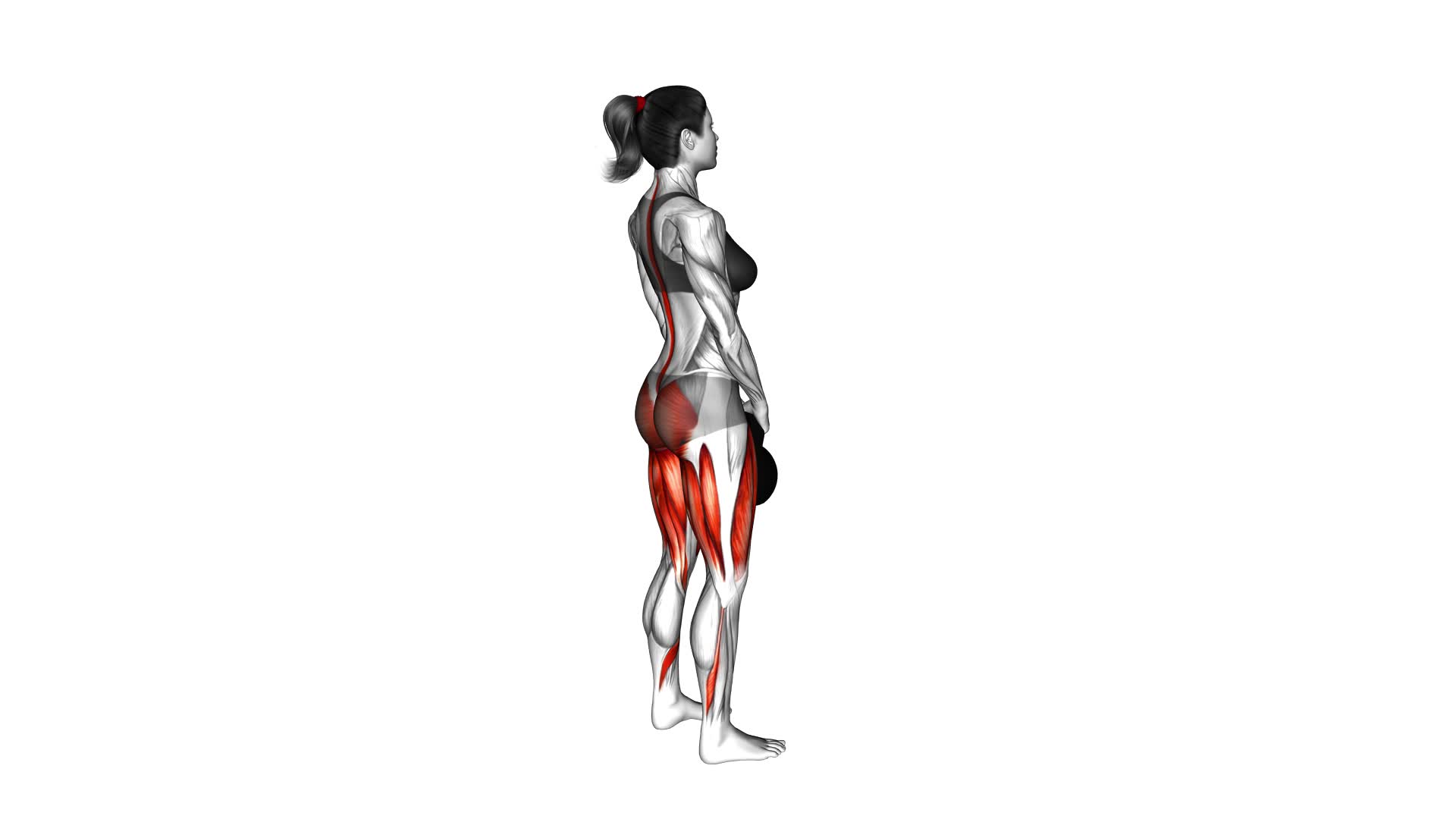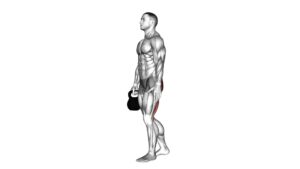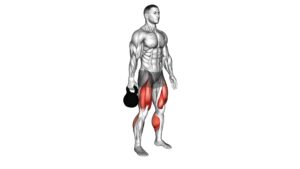Kettlebell Deadlift (Female) – Video Exercise Guide & Tips

Are you looking to strengthen your lower body and improve your overall fitness? Look no further than the kettlebell deadlift!
Watch This Exercise Video
In this video exercise guide, we will show you the proper form and technique for performing this effective exercise. Avoid common mistakes and learn variations and progressions to challenge yourself.
With these tips, you'll be able to maximize your results and achieve your fitness goals. So grab a kettlebell and get ready to start deadlifting like a pro!
Key Takeaways
- Engages multiple muscle groups simultaneously
- Promotes functional strength and overall functional fitness
- Increases overall strength and power
- Promotes fat loss and calorie burn
Benefits of the Kettlebell Deadlift
Experience the numerous benefits of the Kettlebell Deadlift by incorporating this exercise into your fitness routine. The Kettlebell Deadlift is a highly effective exercise that engages multiple muscle groups and promotes functional strength.
One of the key benefits of the Kettlebell Deadlift is its ability to engage various muscles simultaneously. This exercise primarily targets the glutes, hamstrings, and quadriceps, but it also activates the core muscles, including the abs and lower back. By engaging these muscles, the Kettlebell Deadlift helps to improve overall strength and stability in the lower body.
In addition to muscle engagement, the Kettlebell Deadlift also promotes functional strength. Functional strength refers to the ability to perform everyday activities with ease and efficiency. This exercise mimics the movement patterns involved in lifting objects off the ground, making it a practical exercise for improving strength in real-life situations.
By regularly incorporating the Kettlebell Deadlift into your fitness routine, you can expect to see improvements in muscle strength, endurance, and overall functional fitness. This exercise not only helps to build a strong and toned physique, but it also enhances your ability to perform daily tasks with ease.
Proper Form and Technique
To perform the Kettlebell Deadlift with proper form and technique, it's important to maintain a strong and stable position throughout the exercise. Here are some key points to keep in mind:
- Proper alignment: Stand with your feet shoulder-width apart and the kettlebell placed between your feet. Keep your back straight, shoulders back, and core engaged throughout the movement. This will help ensure proper alignment and prevent injuries.
- Hinge at the hips: As you lower your body to grab the kettlebell, hinge at the hips while keeping your back straight. Avoid rounding your back or bending your knees too much. This will engage your glutes and hamstrings, maximizing the effectiveness of the exercise.
- Avoid common errors: One common mistake is lifting the kettlebell with your arms instead of using your legs and hips. Remember, the power should come from your lower body, not your upper body. Also, avoid jerking or swinging the kettlebell, as this can strain your lower back.
- Controlled movement: Slowly lift the kettlebell by driving through your heels and extending your hips and knees. Keep your core tight and maintain control throughout the entire range of motion. Lower the kettlebell back down with the same controlled movement.
Common Mistakes to Avoid
Avoid these common mistakes when performing the Kettlebell Deadlift to ensure proper form and maximize results. Making these errors can't only compromise your technique but also increase the risk of injury.
One mistake to avoid is rounding your back during the movement. This puts excessive strain on your spine and can lead to back pain. Instead, focus on maintaining a neutral spine throughout the exercise by engaging your core and keeping your chest lifted.
Another mistake is using your arms to lift the kettlebell instead of your legs and hips. Remember, the power should come from your lower body, specifically your glutes and hamstrings.
Additionally, avoid locking out your knees at the top of the movement. This can strain your joints and prevent you from fully engaging your muscles. Instead, maintain a slight bend in your knees to keep tension on the muscles.
By avoiding these mistakes and implementing these tips for improvement, you can perform the Kettlebell Deadlift with proper form and achieve optimal results.
Now, let's move on to the next section about variations and progressions.
Variations and Progressions
Now, let's explore some variations and progressions for the Kettlebell Deadlift to challenge your muscles and continue to improve your technique. By incorporating different variations into your training routine, you can target specific muscle groups and prevent plateaus.
Here are four kettlebell deadlift variations to consider:
- Single-Leg Kettlebell Deadlift: This variation adds an extra challenge by requiring you to balance on one leg while performing the deadlift. It engages your core muscles and improves stability.
- Sumo Kettlebell Deadlift: By taking a wider stance and gripping the kettlebell with both hands between your legs, you shift the focus to your inner thighs, glutes, and hamstrings. This variation is great for developing lower body strength.
- Romanian Deadlift: In this variation, you hinge at the hips with a slight bend in the knees and lower the kettlebell towards the ground while keeping your back flat. It targets your hamstrings and glutes more intensely.
- Kettlebell Swing: This dynamic exercise involves swinging the kettlebell between your legs and using the momentum to lift it to shoulder height. It works your entire posterior chain, including your glutes, hamstrings, and back.
To continue progressing with your kettlebell deadlift, incorporate progressive overload techniques such as increasing the weight, repetitions, or sets, or reducing rest time between sets. Remember to always prioritize proper form and technique to prevent injuries and maximize results.
Tips for Maximizing Results
For optimal results, make sure to incorporate these tips into your kettlebell deadlift routine.
First and foremost, focus on maximizing intensity during your workouts. This means lifting heavier weights and increasing the number of repetitions or sets. By challenging your muscles to work harder, you can stimulate more growth and improve your overall strength.
Additionally, pay attention to your nutrition. Fueling your body with the right nutrients is crucial for muscle recovery and growth. Make sure to consume enough protein to support muscle repair, as well as carbohydrates for energy and fats for hormonal balance. Stay hydrated and consider adding supplements like creatine or branched-chain amino acids to enhance your performance and recovery.
Lastly, don't forget to prioritize rest and recovery. Your muscles need time to repair and grow stronger, so make sure to get enough sleep and allow for adequate rest days between workouts.
Frequently Asked Questions
Are Kettlebell Deadlifts Suitable for Beginners?
Kettlebell deadlifts are a suitable exercise for beginners. They help improve your strength and target multiple muscle groups, including your glutes, hamstrings, and lower back.
To perform them with proper form, start by standing with your feet hip-width apart and the kettlebell between your feet. Bend your knees and hinge at your hips as you reach down to grab the kettlebell's handle.
Keep your back straight and lift the kettlebell by extending your hips and knees.
Can Kettlebell Deadlifts Help Improve Posture?
Kettlebell deadlifts are a great exercise for improving posture. By incorporating them into your workout routine, you can enjoy several benefits.
They help strengthen your overall body and improve your strength and conditioning.
Additionally, kettlebell deadlifts target your core muscles, which can help improve core stability and balance.
Is It Necessary to Use a Specific Weight for Kettlebell Deadlifts?
When it comes to kettlebell deadlifts, using a specific weight isn't necessary. It all depends on your fitness level and goals.
For beginners, it's recommended to start with a lighter weight to focus on proper form and technique. As you progress, you can gradually increase the weight to challenge yourself.
How Often Should Kettlebell Deadlifts Be Performed to See Results?
To see results from kettlebell deadlifts, it's important to consider the frequency of your workouts. How often you perform this exercise will determine its effectiveness.
By incorporating kettlebell deadlifts into your routine two to three times a week, you can start seeing improvements in strength, muscle tone, and overall fitness. Remember to focus on proper form and gradually increase the weight as you progress.
Consistency is key for achieving the desired results.
Can Kettlebell Deadlifts Be Performed by Individuals With Lower Back Pain?
If you have lower back pain, there are modifications you can make to perform kettlebell deadlifts safely. Focus on keeping your back straight and using lighter weights.
You can also try alternatives like dumbbell deadlifts or hip thrusts, which put less strain on your lower back.
It's important to listen to your body and consult with a professional if you're unsure.
Make sure to prioritize proper form and start with lighter weights to avoid exacerbating your pain.
Conclusion
In conclusion, the kettlebell deadlift is a highly effective exercise for women that offers numerous benefits, including improved strength, stability, and overall body tone.
By following proper form and technique, avoiding common mistakes, and incorporating variations and progressions, women can maximize their results and achieve their fitness goals.
Incorporating the kettlebell deadlift into your workout routine can lead to significant improvements in your overall strength and physical fitness.

Author
Years ago, the spark of my life’s passion ignited in my mind the moment I stepped into the local gym for the first time. The inaugural bead of perspiration, the initial endeavor, the very first surge of endorphins, and a sense of pride that washed over me post-workout marked the beginning of my deep-seated interest in strength sports, fitness, and sports nutrition. This very curiosity blossomed rapidly into a profound fascination, propelling me to earn a Master’s degree in Physical Education from the Academy of Physical Education in Krakow, followed by a Sports Manager diploma from the Jagiellonian University. My journey of growth led me to gain more specialized qualifications, such as being a certified personal trainer with a focus on sports dietetics, a lifeguard, and an instructor for wellness and corrective gymnastics. Theoretical knowledge paired seamlessly with practical experience, reinforcing my belief that the transformation of individuals under my guidance was also a reflection of my personal growth. This belief holds true even today. Each day, I strive to push the boundaries and explore new realms. These realms gently elevate me to greater heights. The unique combination of passion for my field and the continuous quest for growth fuels my drive to break new ground.







